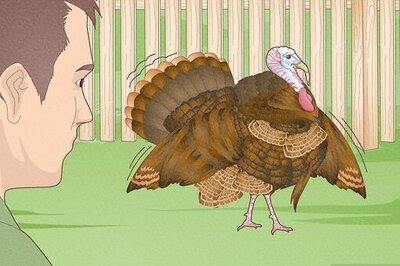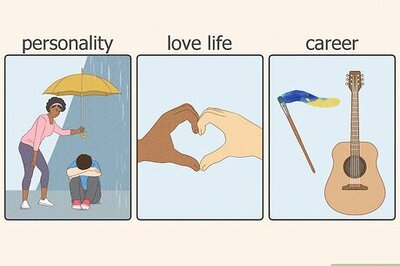
views
I was saddened to read about the passing of Patrick French, whose book I read and reviewed about a decade ago for a respected US journal which accepted the review but somehow, never published it. Later, Patrick and I corresponded and he published my review essay Hinduism and its Culture Wars on his website – The India Site. He was an excellent editor who made you feel you belonged to the calling, club, cult, or craziness called writing, and I enjoyed working with him very much. He was also kind enough to lend a sympathetic shoulder when I got trolled by some RW types after he published my essay. We later met briefly in India at a conference too. With condolences to his family and dear friends, I share my unpublished essay below because I think it is a marker of a key moment when the academic-literary ‘establishment’ could have welcomed a differing view instead of shrinking into its own propaganda ever since. Thank you, Patrick French, for your friendship, brief as it was.
The review below was written in 2011.
British historian Patrick French’s ‘India: A Portrait’ is notable for the lack of welcome it has received from some of the most famous names in the South Asian canon. Aravind Adiga, an Indian novelist and former Time magazine correspondent, wrote in the Guardian that it contained “not a scintilla of original thinking.” The writer and New York Review of Books contributor Pankaj Mishra’s review of it in Outlook was entitled “Curzon without an empire” for that is how full of imperialism Mishra judged French’s work to be. Other reviewers were sorely offended that French dared to question the views of the Indologist Wendy Doniger, the economist Amartya Sen, and the social historian Romila Thapar on Hindu identity.
Underlying these criticisms is the insinuation that Patrick French failed to capture the “real” India of the poor and the oppressed. To be sure, with all its energy and contradictions, the real India eludes easy representation. But the group of writers and scholars who write about it for Western readers, seem to have at least concluded that it does not include the Indian middle class. They dismiss Bollywood, India’s biggest cultural mirror, as mere escapist fantasy while they celebrate the outrageously contrived Slumdog Millionaire’s gritty ‘realism.’ Indeed, when Slumdog opened in theatres in 2008, it marked the worldwide spread of an authenticity fetish that has occupied the South Asian intellectual world for some time. The terms of this obsession go beyond slums and sewage, although they include that, too. Its defining feature is an ambivalence toward anything that resembles how Indians, and especially middle-class Indians, see themselves.
It is thus also unsurprising that French’s India has been found lacking by critics. Of course, French does not, as his critics imply, disenfranchise the poor by exhibiting sympathy for the middle class. He states that his goal was, in fact, to write a book that “looks at India in a new way, for what it was becoming rather than for what others wanted it to be.” And he succeeds. In a way that few have, French shows how central middle-class opportunity and self-perception are to India today — without overlooking the voices of those one ought to remain most concerned about, the poor, the minorities, the dissidents, the margins of the Indian success story.
India is organised in three broad sections: politics, economics, and society. It begins with a historic overview of India’s post-independence political vision and moves into the present, which is filled with entrepreneurs, computer engineers, and first-generation middle-class members. Underlying all these sections, and especially the last one is a central point of Indian middle-class self-perception: the value of all sorts of knowledge — spiritual, historical, and modern. Whether quoting Nehru writing about the need for India to nurture geniuses, young computer scientists applying Hindu philosophical metaphors to their work, or the celebrated lunch-box carriers of Mumbai jokingly referring to their distinct white caps as “computer covers,” India presents Indians as they see themselves: intelligent, ingenious, enterprising, optimistic — and, quite differently from Nehru’s time, as Hindu, too.
French spends more time on successful Indians than poor ones, but does so in an effort to find the roots of India’s enormous recent gains than ignore the fates of those who have not yet prospered. One appalling story he narrates pertains to Venkatesh, a poor farm worker whom a cruel landlord had once forced into shackles to work off a debt. French meets the worker, who is now free and uses his example as a poignant counterpoint to the many who have moved within two generations from poverty to the middle class. The best example of this is Mack, a Yahoo engineer who lives in the San Francisco Bay Area. Mack drives an Acura. His grandfather was a landless farm worker who lived in a thatched hut in a village outside of Bangalore. Mack’s father and uncles walked miles to school, barefoot. They migrated to the city, got college educations with the help of ties to their community, and assumed middle-class lives, which Mack was born into. French wonders how many generations it would take for someone in Venkatesh’s situation to become a software engineer. To some reviewers, this question was seen as offensive, implying that menial labourers must eventually become productive, Westernized engineers. But French’s question is really being posed to a nation, not an individual. French answers it too: in Ramappa’s case, it took only one.
India’s huge middle class, with its 250–350 million members, is largely the product of India’s economic liberalization in the last three decades. Supporters and critics have their own theoretical quarrels with the process, but French recognizes the importance of understanding the way Indians perceived it — in familial and generational terms. More Indians wake up now with the belief that their lives are better than their parents and that their children’s lives will be even better than their own. According to a report by the New Delhi-based Centre for the Study of Developing Societies, an “overwhelming majority of youth are optimistic about the future.” This is in contrast to the United States, for example, where the majority of young people expect their lives to be worse than their parents. Moreover, unlike in the West, where successive cohorts of youth have confronted adulthood by rebelling against their parents, successive generations in India are “rebelling in” to middle-class notions of work and success.
Most of today’s middle-aged Indians grew up in a somewhat austere era, before liberalization really took off. They do not see their children’s enthusiastic embrace of opportunity, material success, or the West, as something to be ashamed of. On the contrary, they have expanded their ideas of tradition to accommodate new, global notions of success. To illustrate this, one might recall that when Mahatma Gandhi returned to India from London after his studies, he had to conduct religious purification rites for breaking a caste taboo on foreign travel. Today, Indian parents offer prayers to ensure their children get college admissions and visas to go abroad. As the new generation has its own children, it will increasingly make demands on the world to recognize them as successful members of the global economy, no matter what they believe at home. For anyone who studies India’s rise, an understanding of the country’s simultaneous emphasis on mobility and tradition will be essential.
In addition to his economic portrait of the middle class, French also offers a vivid impression of the political rise of previously marginalized communities. Contrary to the “real India” lore, which assumes a static social hierarchy in India, French recognizes changes. Since 1989, when regional political parties started their ascendance and numerous caste-based parties such as the Bahujan Samaj Party (BSP) and Janata Dal (JD), as well as the Hindu nationalist Bharatiya Janata Party (BJP), became popular, too, no single group has enjoyed a monopoly on power. In real terms, the greatest absolute increase in power has been among communities known as the Other Backward Castes, many members of whom are two or three generations into prosperity.
The Dalits, the least privileged community, has also more aggressively asserted itself into politics. French chronicles the rise of Mayawati, a Dalit woman, who became the Chief Minister of Uttar Pradesh most recently in 2007. That Mayawati would be something of a hero to previously powerless Dalits is not surprising, but French also reveals an unlikely part of her support base — impoverished Brahmins, who value political and economic security over ancient prejudices. Mayawati’s story is not isolated. Many different groups of Indians are on the rise, and as a consequence, at least some of the old caste equations have fallen. Whether this movement is a truly democratic, egalitarian, and sustainable one, French does not presume to judge, except to note that there are still limits to the spread of power across India’s whole population. For example, French commissions a detailed study of Parliament for his book and finds that electoral politics in India still remain largely hereditary. A large number of young Members of Parliament (MP) turn out to be sons of earlier members.
Much to the discomfort of the “real India” purists, French goes on to explore the role of religion in Indian life. In their zeal to come to terms with the fact of Hindu nationalism, experts such as Thapar and Doniger have espoused an academic definition of Hinduism that most Indians would find unfamiliar. Some, rather than merely taking a stand against extremists, deny India’s Hindu heritage altogether. French points out the presumptiveness of Sen’s assertions that India’s Hindu past is a “pure illusion.” French also acknowledges the difference in how academics write about India’s various religions. Few scholars, he suggests, would presume to title a book “The Muslims: An Alternative History” in the manner of Wendy Doniger’s “The Hindus: An Alternative History.”
All this speaks to a deeper issue: Who gets to speak for a culture or a nation? Within India, the democratic process has started to open the floor to everyone. The purists have found that distasteful. So, too, have they been opposed to studies by outsiders, such as French, whose British nationality seems objectionable (as seen in the Curzon reference in Mishra’s review, for instance). But for most Indians in India, French’s heritage does not disqualify his work. A few years ago, on a visit to England, Prime Minister Manmohan Singh chose to praise the contributions of the British to India rather than dwell on the past evils of colonization. This was a deliberate shift that won the support of at least some Indian intellectuals. And opinion polls find that Indians have one of the highest favourable impressions of the United States in the world.
At any rate, it is time to entertain more diverse and nuanced views about India. The field has room for studies about India’s failures, the margins of its society, its poor and minorities. So, too, does it have room for its success stories. India lives up to the author’s goal of depicting a nation as it is rather than as one hopes or despairs it might be. Coupled with the screening of an entertaining Indian film, it might prove more educational about how India sees itself today than Slumdog Millionaire or its literary counterparts.
The author is PhD, Professor of Media Studies, University of San Francisco. Views expressed are personal.
Read all the Latest Opinions here


















Comments
0 comment